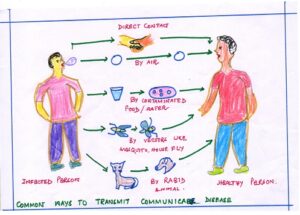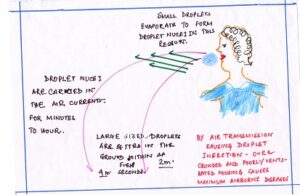CONCEPT OF DISEASE
COMMUNICABLE AND NON COMMUNICABLE
INTRODUCTION:
The disease is the malfunctioning of the body organs due to one reason or the other. In other words, it is a disorder of the body. The state of the body when any of its normal functions are disturbed or when the structures are altered is called disease. We understand that to remain healthy, we need to do much more than just keep away from disease.
The pattern of disease: Based on their pattern of spread, diseases can be categorized as follows:
- Endemic: When the occurrence of disease is restricted to a certain area and affects only a few number of people then the disease is called endemic. As for example, Goitre is found in the sub-Himalayan region of India and Yellow fever in certain African countries.
- Epidemic: When the disease breaks out and spreads rapidly from place to place affecting a large number of people. As for example, in 1997 Plague was assumed epidemic killing several numbers of people.
- Pandemic: When the disease spreads worldwide. As for example, AIDS as it is spreaded whole world.
- Sporadic: When there are scattered cases of disease, it is called sporadic. E.g. Dengue.
TYPES OF DISEASES
Diseases can be broadly classified as congenital and acquired diseases.
- CONGENITAL DISEASE: This type of disease is present right from the birth. This is caused either due to genetic disorders or gene mutation or environmental factors. These diseases are passed on from one generation to next generation. Some examples of congenital diseases are Haemophilia, Sickle cell anaemia, Colour blindness, Thalassaemia etc.
- ACQUIRED DISEASES: These diseases are acquired by the organisms after birth and are not heritable. They are not passed on to the offspring. Such diseases are further classified into:
- Non communicable disease: These diseases do not spread from person to person and remain restricted to one person. These diseases are not caused by pathogens or germs. These are of the following types.
- Degenerative diseases: These are the diseases of old age caused due to the gradual decline in the functioning of body organs like heart, kidneys, lungs, hardening of arteries or arteriosclerosis and aching of joints and degeneration of body tissues.
- Deficiency diseases: These diseases are caused by the deficiency of one or more nutrients in the diet. E.g. anaemia, night blindness, rickets etc.
- Allergies: These are caused due to hypersensitivity of the body to any foreign substance. E.g. hay fever, asthma.
- Cancer: It is caused by uncontrolled divisions of cells in any part of the body to form a mass of cells, called tumour. Cancer has several causes e.g. lung cancer due to smoking tobacco, skin cancer due to exposure to UV rays, mouth cancer, due to chewing tobacco.
- Life style or social diseases: These are resulted from the condition in which we live. Many factors such as stress, smoking, high fat diet, and lack of exercise cause heart disease. All these factors vary according to the lifestyle or the way of living of a person.
- Mental illness: It includes disorders like dementia, schizophrenia and depression. These are caused due to stress in daily life such as accidents or death of a loved one etc. People may become irritable or extremely anxious and depressed.
- Communicable disease: These diseases are infections or transmissible diseases which spread from one person to another by various agents such as air, water, food and insects. These diseases are caused by pathogens that live on or in our body.
Pathogens (Pathos- disease; gen- producing) are living organisms such as viruses, fungi, bacteria, protozoans and worms that live on or in the human body and cause diseases. Pathogenic microorganisms are called germs.
HOW DO PATHOGENS CAUSE DISEASES?
Body tissues and systems can be damaged by pathogens in the following way:
- True infection: The pathogen enters the body and develops a mechanism by which it is not damaged by the white blood cells. It then adheres to the cells in the body of host and harms these cells.
- Releasing toxins: Some pathogens release certain chemicals called toxins as soon as they enter the host’s body. These toxins cause disease symptoms such as fever, vomiting, headache etc.
- Secondary infections: Certain parasitic worms bore through the host tissues causing wounds. These wounds may then become infected with germs. This is called secondary infection.
Mode of transmission of infectious diseases
Infections or communicable diseases spread from an infected person to a healthy person in two ways- direct transmission and indirect transmission.

Fig#1 diagram of common way to transmit communicable disease
a)DIRECT TRANSMISSION: The pathogens of certain diseases react and infect a healthy person directly without an intermediate agent. It can take place by various means
*Direct contact between the infected person and healthy person: Direct contact with the discharge from lesions or sores on the skin may cause infection. Eg small pox, chicken pox, sexual act is sometime becomes cause of direct contact resulting syphilis and AIDS.
*Droplet infection: Droplets are airborne. The infected person releases out tiny mucus droplets by the action of coughing, sneezing, spitting or even talking. Sometimes these droplets may contain infectous pathogens. A healthy person may be infected by inhaling air with droplets. Diseases like common cold, pneumonia, influenza, measles, mumps and tuberculosis spread by droplet infection. Since the larger droplets take a few seconds to a few minutes to reach a nearby person, we should cover our mouth while sneezing or coughing.

Fig#2 diagram of types of droplet infection
*Contact with soil contaminated with disease causing viruses: The bacteria responsible for tetanus enters the human body from the soil.
b) INDIRECT TRANSMISSION: The pathogens of certain diseases reach human body through some intermediate agents. It can take place by various means like:
* By vectors: Houseflies, mosquitoes and cockroaches which take up the pathogen from the reservoir of infection pass it to healthy persons. These are called as vectors. For examples, houseflies carry the causative organisms of cholera, typhoid, dysentery and tuberculosis on their legs and mouthparts from the faeces and sputum to food and drinks and contaminate them. When the contaminated food is taken by a healthy person, he or she gets infection. The commonest vector is the mosquito. Female mosquito of many species require blood containing highly nutritious food in order to lay mature eggs. Mosquitoes feed on warm blooded animals including human and in turn transmit diseases from one person to another.
*Airborne: The pathogens may reach the humans with air and dust. The epidemic Typhus disease is spread by infected lice which releases faeces, these dried faeces causes the typhus. For example, tuberculosis, influenza, common cold and pneumonia.
*Waterborne: Diseases also spread through water contaminated with microbes. For example, contaminated water may contain excreta from someone suffering from infectious gut diseases, such as dysentery, cholera etc. When this water mixes with the water used for drinking, the cholera causing microbes will enter the new hosts and cause diseases in them. Cholera , hepatitis B and diarrhea spread through such mode.
*Dirty hand and fingers: These are also sources of infection for various digestive and respiratory diseases.
*Myiasis: It is a new term ever. Before ending we must know about this. This is condition when the young ones or larvae of houseflies enter the human body and live there. It is reported that the larvae of some species of houseflies enter the urogenital tract of human causing urogenital myiasis. They may also enter the respiratory tract through the nose causing nasopharyngeal myiasis.
